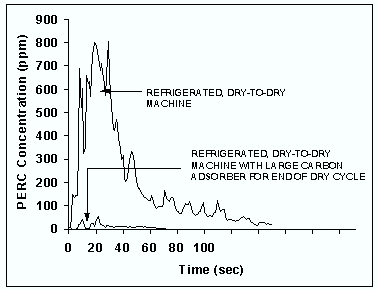Control of Exposure to Perchloroethylene in Commercial Drycleaning
1997
DHHS (NIOSH) Publication Number 97-154
Hazard
Perchloroethylene (PERC) is the most commonly used drycleaning solvent. PERC can enter the body through respiratory and dermal exposure. Symptoms associated with exposure include: depression of the central nervous system; damage to the liver and kidneys; impaired memory; confusion; dizziness; headache; drowsiness; and eye, nose, and throat irritation. Repeated dermal exposure may result in dermatitis. NIOSH considers PERC a potential human carcinogen.
Controls
To reduce exposure to drycleaning solvents, a comprehensive control approach should be followed involving engineering measures, work practices, and personal protection. Engineering measures are the preferred and most effective means of control and should generally be considered first.
Material Substitution
- Technologies are available to reduce dramatically occupational exposures to PERC in the commercial drycleaning industry. Alternative cleaning media, such as wet cleaning and petroleum-based solvents and machines, are available and effective. Several studies report that 30% to 70% of garments drycleaned using PERC can be wet cleaned satisfactorily while controlling fabric deterioration and shrinkage. For more information about Substitution, see HC17, NIOSH Publication No. 97-155.
Isolation
- Large drycleaning companies should use satellite stores that do not perform drycleaning on the premises. When possible, new shops should be located in stand-alone buildings to reduce the risk of contaminating adjacent apartment buildings or food stores.
- Within shops, drycleaning machines should be isolated from other work areas. Because the majority of PERC emissions originate at the machine, isolating employees from the drycleaning machines will reduce exposures.
Machine Design
- Loading and unloading the drycleaning machine are the greatest sources of worker exposure. Modern drycleaning machines with both a refrigerated condenser and carbon adsorber are available to reduce exposures during machine loading and unloading (Figure 1). They reduce full-shift PERC exposures to below 5 parts per million (ppm), save money in solvent costs, and permit easier compliance with safety, health, and environmental regulations. For more information about Machine Design, see HC 18, NIOSH Publication No. 97-156.
Maintenance
- Proper maintenance is important for reducing exposures and increasing the life and performance of the machine. Maintenance should be done properly to prevent the performance of the drycleaning machine from degrading, which might result in increased solvent exposures. Maintenance activities that are particularly important in reducing solvent exposures include ensuring vapor recovery systems are in good working order and checking for liquid and vapor leaks on equipment piping and ductwork and on the machine. When available, follow the maintenance recommendations from the manufacturer.
- Workers should wear proper personal protective equipment (gloves, goggles, and respirators) to reduce exposures to PERC during maintenance activities.
Ventilation
- Proper ventilation in the shop will control worker exposure to PERC and ensure thermal comfort. Ventilation control should be accomplished by capturing and removing the contaminant at or near the source (local ventilation) or by diluting the concentration of the contaminant before it reaches the worker’s breathing zone (general ventilation). Local ventilation should be used in drycleaning shops to reduce worker exposure during machine loading and unloading and while performing maintenance. Drycleaning machines with an integral exhaust system should have an inward air velocity through the loading door of 100 feet per minute (fpm) and should be passed through a control device containing activated carbon to recover solvent vapors. General ventilation should be used to add fresh air or remove air to dilute background PERC concentrations; a complete air change should occur in the work room every 5 minutes. For more information about Ventilation, see HC 19, NIOSH Publication No. 97-157.
Work Practices
- Operators should not open the door of the drycleaning machine while it is running. The drying period should not be cut short. The machine door should be closed except during loading and unloading. The operator should keep his or her head out of the machine and should stay as far away from the door during loading and unloading as possible. A tool with a long handle could be used to retrieve clothes at the back of the drum.

Figure 1. Operator exposure when loading or unloading a dry-to-dry, refrigerated, drycleaning machine vs. same machine with a retrofitted large, closed-loop, carbon absorber used as a secondary vapor control system.A NIOSH technical report, Control of Health and Safety Hazards in Commercial Drycleaners: Chemical Exposures, Fire Hazards, and Ergonomic Risk Factors, has been published on this subject. This document is one in a series of seven HAZARD CONTROLS concerning control of hazards in the drycleaning industry that are available free upon request.
*NIOSH is the Federal agency responsible for conducting research and making recommendations for preventing work-related illnesses and injuries. All HAZARD CONTROLS are based on research studies that show how worker exposures to hazardous agents or activities can be significantly reduced.
Acknowledgments
The principal contributors to this publication are Gary S. Earnest, Lynda Ewers, Avima Ruder, Linda Goldenhar, Rosmarie T. Hagedorn, and Jerome P. Flesch.
This document is in the public domain and may be freely copied or reprinted. NIOSH encourages all readers of this HAZARD CONTROLS to make it available to all interested employers and workers.
Control of Exposure to Perchloroethylene in Commercial Drycleaning
